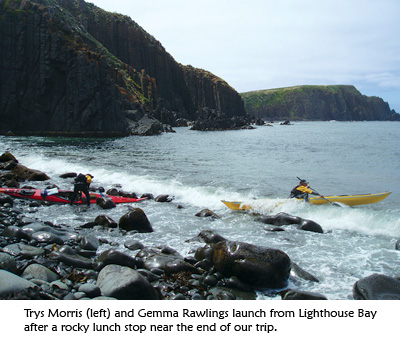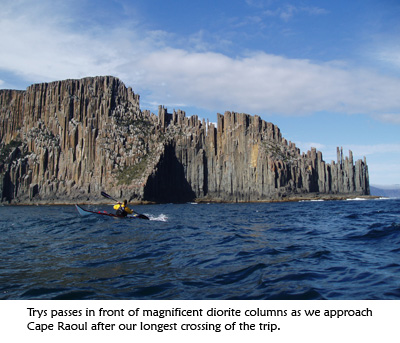Three Paddlers from the U.K. are the first women to take on the 900-mile circumnavigation of Tasmania.

We’re not going anywhere! This is pointless! Trys shouted into the wind. My heart sank—I didn’t want to stop. Ahead of us, tantalizingly close, lay a headland that would offer us some protection from the wind. If only we could reach it, we could go ashore and camp beneath the trees. Trys was right, though—we’d been paddling for two hours and had barely made a mile. The sea and wind were stinging our eyes as we battled, head-down, into the full force of a gale. Again.Trys, Gemma and I all desperately wanted to complete our circumnavigation of Tasmania in the six weeks we’d allocated, but day after day, we had faced strong headwinds. The demoralizing and energy-sapping weather meant that after the first two weeks of paddling, we were already behind schedule, and we needed to paddle whenever possible. We’d hoped to make up some time that morning when we left the North Coast town of Bridport. The wind had already been buffeting the trees, so we tried sticking close to shore to sneak along the coast for as long as possible. Unfortunately, the wind had picked up until it was stronger than we were.
“Can we just push it for a few more minutes and get to the beach ahead?” I hollered back.
The three of us were only a few yards apart, but the wind tore our words from our lips.
“We can try,” Trys bellowed, unconvinced but charitable. Gemma nodded agreement.
I tried to guess how far away the headland was. It must be only 400 yards ahead. Surely we could reach it. Five minutes passed. Ten minutes. My face was chapped from the sting of the wind. My kayak bounced and thudded down into the chop, but the headland wasn’t getting any closer.
“This IS pointless!” Gemma shouted.
My shoulders and head dropped with frustration, and I knew she was right. Reluctantly, I pointed my kayak toward the beach to our left, hoping we could land there. Unfortunately, the choice that lay in that direction wasn’t great. Four hundred yards of shallows separated us from high ground. It would be exhausting to haul our heavily laden kayaks there and back. The only real option was to turn back to Bridport. It would be gut-wrenching to retreat after two hours of intense effort, but I knew it was the most sensible choice. On a calm day, we could recover the progress we’d lost in 20 minutes, but I ached all the same. It felt so unfair that we could try so hard and fail. I choked back tears and wondered if the weather would ever allow us to make it around the island.

Where I live, in rural New England, if you ask old-timers for directions to a nearby town, they’re apt to tell you that “you can’t get there from here.” For North American paddlers flying commercial airlines to kayaking and camping trips, the issue is not whether you can get there, but whether your gear can. Things like fuel canisters and flares are pretty obvious no-fly items. But what about candles, seam sealer, insect repellent or bear repellent spray? The U.S. government and many commercial airlines prohibit flying with a growing number of standard kayak and camping gear items. Given increased restrictions and the potential of costly fines, what’s a paddler to do?

